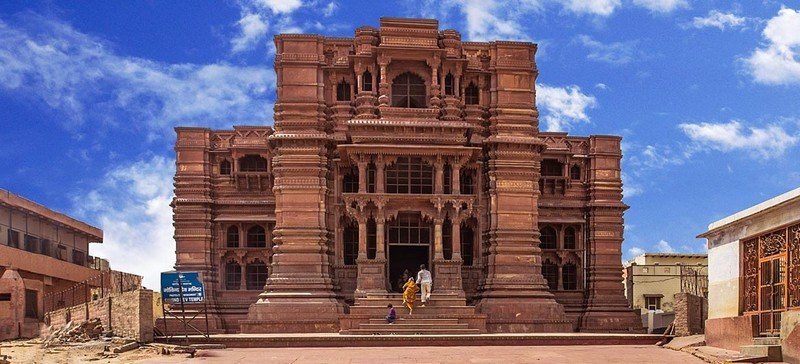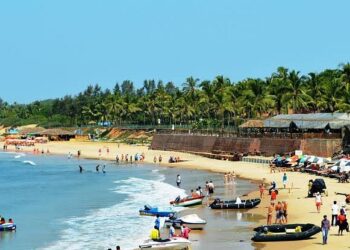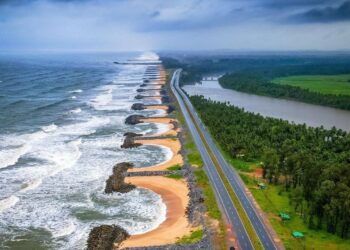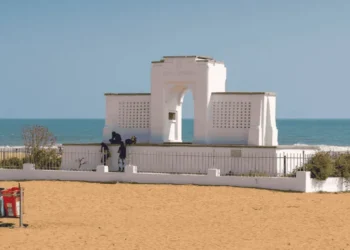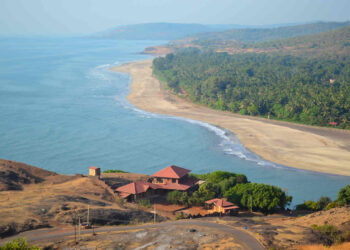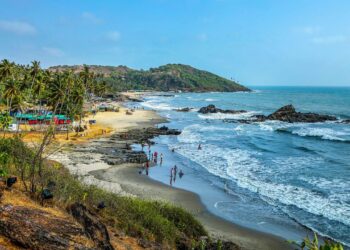Governed by tradition and royalty alike, the Govind Dev Ji Temple stands at the heart of Jaipur’s history. It is a significant Hindu shrine dedicated to Radha and Krishna, situated within the City Palace complex. Completed in 1735 under Maharaja Sawai Jai Singh II (Jaipur’s founder), it enshrines the deity Govind Dev Ji – an incarnation of Krishna that was already revered as the family god of the Amber (Kachawaha) dynasty.
History of Govind Dev Ji Temple
Local lore traces the idol’s origin to Vrindavan: legend says Krishna’s great-grandson Bajranabh sculpted the original image from memory of the deity’s form. As per ancient belief, Bajranabh, the great-grandson of Lord Krishna, crafted three distinct idols to honor the deity. Each statue symbolized a different part of Krishna’s divine form: one depicted His feet, another His torso, and the third captured His face. These sacred representations came to be revered as Madan Mohan Ji, Gopinath Ji, and Govind Dev Ji, respectively.
The temple holds profound historical and spiritual value. It is the very place where the esteemed Gaudiya Vaishnava scholar Baladeva Vidyabhushana authored the renowned Govinda Bhashya, a detailed exposition on the Brahma Sutras. This monumental work was undertaken following a divine dream in which Lord Govind Dev Ji is said to have provided inspiration and guidance. Historical accounts record that the idol was rediscovered by the saint Rupa Goswami in Vrindavan around 1525 and then installed in a temple built by Emperor Akbar and Raja Man Singh of Amber. In the 17th century, to protect it from Mughal iconoclasm, priests moved the idol first to Amer, and ultimately, following Aurangzeb’s death, Jai Singh II brought Govind Dev Ji to Jaipur – initially to the Suraj Mahal – before enshrining it in the new palace temple. Thus from its very inception the temple was linked to the city’s rulers and became a focal point of royal devotion.
Architecture of Govind Dev Ji Temple
Architectural guides note that Govind Dev Ji Temple was built in a multistory haveli style. Its pale-ochre walls rise through successive balconies and niches, each level capped by chhatri domes and finials. The entire façade is ornate: carved jali screens, painted surfaces and delicate stone brackets project an aura of regal grandeur. As one official description observes, the temple features “towering rose-hued spires and domes” typical of 18th-century Jaipur craftsmanship. The symmetry of arched windows and corner turrets suggests a miniature royal palace, even as it marks a sacred precinct. Inside, the atmosphere is richly devotional. The rectangular worship hall lacks a soaring shikhara (spire); instead a flat ceiling, encrusted in gold leaf, spans the chamber. Marble pillars with delicate engravings support this gilded canopy, from which dozens of crystal chandeliers are suspended.
Visitors report that the “ceiling is cased with gold,” reflecting the warm glow of oil lamps below. The walls are lined with oil paintings and framed prints of Krishna lore, and the shrine itself rests on a marble platform. Surrounding courtyards are laid out as tranquil gardens, which enhance the temple’s serene ambience. An adjacent modern satsang hall (devotional assembly room) exemplifies contemporary engineering: its roof is a single 119-foot RCC span (reinforced concrete) supported by no columns, a feat certified by the Guinness Book of World Records. This huge, column-free hall can accommodate thousands of worshippers at once, marrying the temple’s ancient style with modern requirements.
Rituals and Celebrations
At the core of the temple’s activity is the sanctum of Govind Dev Ji. Here the idols of Radha and Govind (Krishna) sit enthroned under a silver canopy. Devotees begin the day before dawn: the Mangala aarti ritual bathes, dresses, and adorns the deities in new silken garments and garlands. In total, seven aartis are offered each day – from predawn through the evening – at fixed times. During each ceremony, priests chant and ring bells as brass lamps are waved before the idols. Food offerings (bhog) of fruit, sweets, and kheer are ceremonially presented on silver plates, then later distributed as blessed prasad. The temple staff notes that every aarti involves meticulous service; according to temple literature, the images are bathed, fed, and worshipped with a full ritual sequence seven times daily. Pilgrims come to receive the darshan (viewing) of the idols at each aarti, lending the shrine a continuous cycle of devotion.
Festivals
On major festival days the temple comes alive with even greater fervor. Janmashtami (Krishna’s birthday) and Radhashtami (Radha’s birthday) are celebrated with music, chanting and special pujas. Holi, the spring color festival closely associated with Krishna, is another major occasion here. Government travel guides note that “thousands of devotees” throng the shrine on Janmashtami and Holi. Indeed, during these festivals the temple forecourt is jammed with worshippers who sing kirtans, perform dance rituals, and queue for prasad.
The social spirit is jubilant: priests carry the idol in a mini-procession, and the complex is filled with flowers and lights. As the official description explains, on these days Govind Dev Ji Temple is “one of the most revered temples of Lord Krishna outside Vrindavan,” and its grounds overflow with celebrants. Every year, the Jaipur tourism board highlights Janmashtami as a high point, warning that arriving very early is advisable because of the large crowds. For modern visitors and pilgrims alike, Govind Dev Ji Temple remains both a heritage monument and a living sanctuary. It is administered by the lineage of Goswami priests with the patronage of the former royal family, and to this day its rituals are carried on much as they have been for centuries. Tourists touring the City Palace often include it in their itinerary, noting that unlike the surrounding palaces it is an active mandir, not merely a museum.
Conclusion
Remarkably, the official tourism narrative emphasizes that the shrine is “more than just a place of worship – a melting pot of history, spirituality, and culture” that embodies Jaipur’s legacy. In short, Govind Dev Ji Temple offers a profound slice of cultural continuity with its beautifully carved walls and golden interior come alive through daily rites and festival celebrations, linking Jaipur’s princely past with the devotion of its present.
